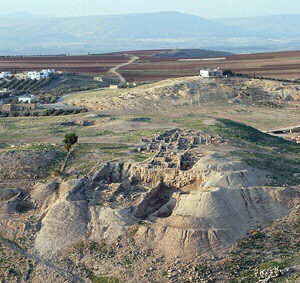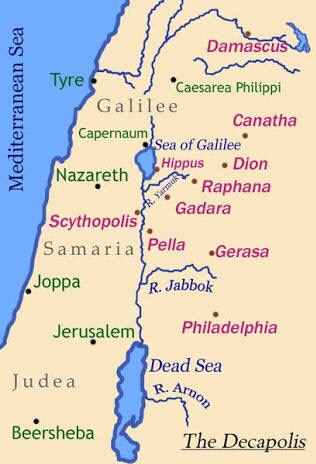1
“There are four rules that can’t be broken” says Dr Stephen Bourke, briefing volunteers (including me) for the 2001 season of the Sydney University dig at Pella in Jordan. I’m uncharacteristically willing to hand over $2000 – and my unskilled labour – in exchange for the excitement, boredom and hard work involved in peeling back the layers of an archaeological site.
“Don’t speak to the trench supervisor for half an hour after work starts,” he continues. “If it’s clean, khaki, or flies a flag don’t photograph it. No hairdryers: use one and you’ll put out the lights of the whole village. Most importantly, Abu Sami rules the kitchen. Oh, and by the way, don’t worry about the political situation. You’ll hear gunfire across the river and Israeli bombers screeching overhead, but you’ll be perfectly safe.”
2
People have lived in Pella without a break for 8000 years. Traces of this history are everywhere. Centuries reel by. Neolithic farmers grow crops, care for animals and build houses. Bronze Age workers construct a vast temple-fortress. Traders offer inlaid ivory boxes, imported pottery, alabaster perfume bottles, objects overlaid with gold. Egyptians are eager to buy timber from the forests to make chariot spokes. The city becomes part of the Decapolis, on the frontier of the Roman Empire. Under Byzantine rule businesses do a roaring trade, churches are built, the population swells. Then plague, the silting of the wadi, and an Ottoman victory that puts it in Muslim hands: it becomes a place to stop on the route to Mecca. The Ottomans lose interest in it, except as a source of taxes, and earthquakes wreak havoc. After World War 1 it becomes part of the Kingdom of Jordan. It is bombarded by the Israelis in the Six Days War. In 1979, Sydney University joins teams already excavating there, and in 2001 I volunteer for two weeks as more work is done uncovering the temple-fortress.
3
Over the years, the Sydney University team has unearthed Neolithic housing (ca. 6000 BCE); Chalcolithic storage complexes (ca. 4200 BCE); Early Bronze Age stone defensive platforms (ca. 3200 BCE); massive Middle Bronze Age mud-brick city walls (ca. 1800 BCE); Middle and Late Bronze Age temples and residences (ca. 1800-1200 BCE); clay tablets in a Late Bronze Age Egyptian Governors’ Residence (ca. 1350 BCE); large areas of a Hellenistic city destroyed by war in 80 BCE; the theatre, baths and fountain-house of the Roman Imperial city (ca. 150 CE); three Byzantine churches and a Bishop’s palace (ca. 550 CE); an Umayyad Islamic city destroyed by an earthquake (ca. 750 CE); an Abbasid caravanserai (ca. 950 CE); and a Mameluke mosque and administrative compound (ca. 1350 CE)
Some of the significant finds so far: column drums, a 10th century BC door; 5 million seeds in a storeroom; a life-sized basalt head; cylinder seals; gold hoop earrings; lapis lazuli; Mycenaean ceramics; tiny faience tiles; early basalt vessels; pottery pomegranates; a lion libation pourer; the earliest Aramaic inscription yet found; seven cult stands; and a cow box for burning incense.
This season the plan is to dig the temple “madly” in an attempt to find out how it was built.
4
Two months after the briefing, it’s pick up time in Amman. The driver of the bus taking us to Pella comes in and introduces himself cheerfully. “We’ll be out of here shortly” he says. “It’ll take a few minutes to check the undercarriage for bombs and then you can start loading your bags.”

A view over Pella

Pella dig site map from Wikipedia

https://commons.m.wikimedia.org/wiki/Pella_in_Jordan#/media/File%3ATemple_Precinct_2007.jpg: photo by Ben Churcher
If you want to know more about Pella and Sydney University’s involvement:.
Detailed history of Pella from Wikipedia
A brief history of the site, written by Ben Churcher who has been involved with the excavations for many years and is currently the field director at Pella
Conversation with a Pella archaeologist. The Pella part of this interview begins at about 9.58
Conversation with Dr Stephen Bourke, dig director in 2001 and for many years before and after
This is background to the next series of Postcards from the past.


I missed this excellent background post to the Jordan expedition. A big adventure through time and space.
LikeLike
This was a post written when I had a writing week with a friend. I just re-read it, and was pleased!
LikeLiked by 1 person
I’m glad you were pleased. You should be!
LikeLike
Your life is amazing Meg,I can’t wait to read more about the dig and the whole experience. Lucky you, but $2000 was alot of money back then!
LikeLike
I’d just inherited from the uncle who lent me archaeology books when I was a kid. It seemed a fitting way to spend a bit. So yes. I was lucky. I only thought it was a lot of money when I was being bullied by the trench supervisor!
LikeLike
I recall being in Delhi shortly after the Taj Mahal hotel bombing in Mumbai and all vehicles arriving at the hotel (we also stayed in a Taj Mahal hotel) were stopped and checked underneath for bombs. It would have made me feel safe if it wasn’t for the fact that on entering the hotel and being ‘wand swept’ the security people seemed to think it was supposed to beep! We were always admitted into the reception area despite multiple beepings sounding out.
LikeLike
I love this sort of exotic chaos – but I get your point!
LikeLiked by 1 person
Oh, most interesting Meg….I’m looking forward to your next postcard!
LikeLike